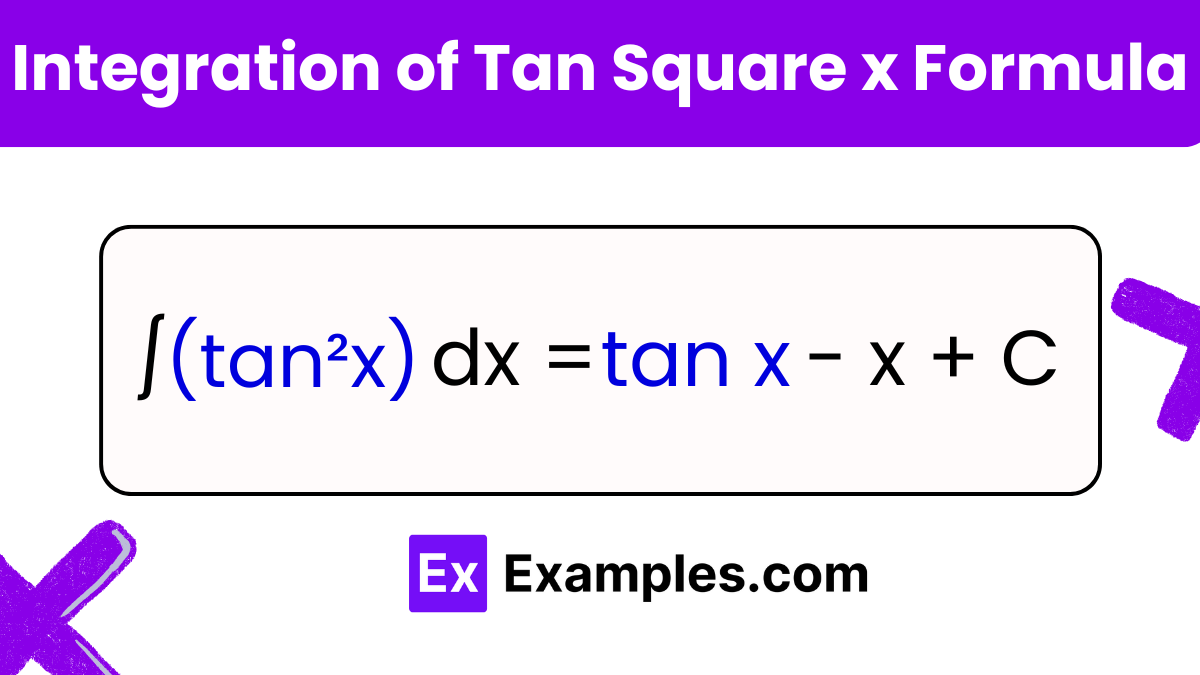What is the integral of \(\tan^2(x) \, dx\)?
\(x - \tan(x)\)
\(x + \tan(x)\)
\(x - \tan^2(x) + x\)
\(x - \tan(x) + C\)


Integration of tan²(x) involves techniques that encompass a broad array of mathematical concepts. From exploring rational and irrational numbers to delving into the realms of algebra and statistics, the process links various foundational elements like integers and square and square roots. Employing methods such as the least squares method in data fitting, this topic extends beyond simple calculus, bridging the gap between numerical theory and real-world applications. Such integrations often challenge our understanding of numbers and their properties, underscoring the interconnected nature of mathematical disciplines.

The integral ∫tan²(𝑥) 𝑑𝑥 equals tan(𝑥)−𝑥+𝐶 by utilizing the trigonometric identity tan²(𝑥) = sec²(𝑥)−1. This transformation allows the integration of sec²(x) and −1 separately, simplifying to tan(𝑥)−𝑥, with 𝐶 as the integration constant representing any constant value added to the indefinite integral.
To provide a proof for the integral ∫tan²(𝑥) 𝑑𝑥, we start by utilizing a known trigonometric identity and proceed with basic integration techniques. Here’s a detailed step-by-step explanation:
First, we employ the identity for tan²(x):
tan²(𝑥) = sec²(𝑥)−1
Using the identity, we rewrite the integral:
∫tan²(𝑥) 𝑑𝑥 = ∫(sec²(𝑥)−1) 𝑑𝑥
The integral can now be separated into two simpler integrals:
∫tan²(𝑥) 𝑑𝑥 = ∫sec²(𝑥) 𝑑𝑥−∫1 𝑑𝑥
The integral of sec²(x) is straightforward:
∫sec²(𝑥) 𝑑𝑥 = tan(𝑥)
The integral of 1 with respect to 𝑥 is simply 𝑥:
∫1 𝑑𝑥 = 𝑥
Subtracting the integral of 1 from the integral of sec²(x) gives:
∫tan²(𝑥) 𝑑𝑥 = tan(𝑥)−𝑥+𝐶
Where 𝐶 is the constant of integration.
To find the definite integral of tan²(x) from 0 to 𝜋/4, we can use the previously established integral formula for tan²(x), which is ∫tan²(𝑥) 𝑑𝑥 = tan(𝑥)−𝑥. Applying the limits, we evaluate:
∫tan²(𝑥) 𝑑𝑥𝜋/⁴₀ = [tan(𝑥)−𝑥]𝜋/⁴₀
At 𝑥 = 𝜋/4, tan(𝜋/4)=1, so:
tan(𝜋/4)−𝜋/4 = 1−𝜋/4
At 𝑥 = 0, tan(0) = 0, so:
tan(0)−0 = 0
Subtract the value at the lower limit from the value at the upper limit:
[1−𝜋/4]−[0] = 1−𝜋/4
Problem: Compute the integral of tan²(x) from 𝜋/6 to 𝜋/3.
Solution: Using the identity tan²(𝑥) = sec²(𝑥)−1 and the integral formula:
∫tan²(𝑥) 𝑑𝑥 = tan(𝑥)−𝑥
Evaluating from 𝜋/6 to 𝜋/3:
[tan(𝑥)−𝑥]𝜋/³𝜋/₆ = (tan(𝜋/3)−𝜋/3)−(tan(𝜋/6)−𝜋/6)
Given tan(𝜋/3) = 3 and tan(𝜋/6) = 1/3, the calculation becomes:
(3−𝜋/3)−(1/3−𝜋/6)
Result: The integral evaluates to a specific numerical value, simplifying the expression by combining terms.
Problem: Compute the integral of tan²(x) over one full period, from −𝜋/4 to 3𝜋/4.
Solution: Again using the integral formula:
∫tan²(𝑥) 𝑑𝑥 = tan(𝑥)−𝑥
Evaluating from −𝜋/4 = to 3𝜋/4:
[tan(𝑥)−𝑥]³𝜋/⁴−𝜋/₄ = (tan(3𝜋/4)−3𝜋/4)−(tan(−𝜋/4)−(−𝜋/4))
Since tan(3𝜋/4) = −1 and tan(−𝜋/4)= −1, the calculation becomes:
(−1−3𝜋/4)−(−1+𝜋/4)=−𝜋
Result: The result demonstrates the behavior of the tan²(x) function over its periodic interval.
Problem: Evaluate ∫𝜋₀tan²(𝑥) 𝑑𝑥.
Solution: Direct computation is challenging due to the undefined nature of tan(𝑥) at 𝜋/2. This integral technically diverges as tan²(x) approaches infinity near 𝑥 = 𝜋/2.
Result: The integral does not converge due to the asymptotic behavior at 𝜋/2.
Integrating tan²(x) is often encountered in physics and engineering, particularly in problems involving angular motion and oscillations where tangent functions model behaviors varying over time.
The periodic nature of tan(𝑥) implies that integrals of tan²(x) over its full periods or multiples thereof simplify the evaluation, but care must be taken to avoid points of discontinuity where the tangent function is undefined.
By substituting tan²(x) with sec²(𝑥)−1, the integral breaks into simpler terms, sec²(x) and 1, which are straightforward to integrate individually.
Text prompt
Add Tone
10 Examples of Public speaking
20 Examples of Gas lighting
What is the integral of \(\tan^2(x) \, dx\)?
\(x - \tan(x)\)
\(x + \tan(x)\)
\(x - \tan^2(x) + x\)
\(x - \tan(x) + C\)
Calculate the integral of \(\tan^2(x)\) from 0 to \(\pi/4\).
\(\pi/4\)
\(\pi/4 - 1\)
\(1\)
\(0\)
What is \(\int \tan^2(x) \, dx + C\)?
\(x + C - \tan(x)\)
\(x - \tan(x) + C\)
\(x - \tan^2(x) + C\)
\(x + \tan(x) + C\)
Evaluate the integral of \(\tan^2(x)\) from \(\pi/6\) to \(\pi/3\).
\(\pi/6 - 1/2\)
\(\pi/6\)
\(1/2\)
\(\pi/6 - 2\)
What is the result of \(\int \tan^2(x) \, dx\) if the constant of integration is 5?
\(x - \tan(x) + 5\)
\(x + \tan(x) + 5\)
\(x - \tan^2(x) + 5\)
\(x - \tan(x) + 5x\)
What is \(\int \tan^2(x) \, dx\) if evaluated from 0 to \(\pi/2\)?
\(\pi/2 - 1\)
\(\pi/2\)
\(1\)
\(\infty\)
Find the integral of \(\tan^2(x) \, dx\) for the interval from \(\pi/4\) to \(\pi/2\).
\(\pi/4\)
\(\pi/4 - 1\)
\(\infty\)
\(1\)
What is \(\int \tan^2(x) \, dx\) + 7?
\(x + \tan(x) + 7\)
\(x - \tan(x) + 7\)
\(x - \tan^2(x) + 7\)
\(x - \tan(x) + 7x\)
Determine \(\int \tan^2(x) \, dx\) from \(\pi/4\) to \(\pi/3\).
\(\pi/4 - 1/2\)
\(\pi/4 - 1\)
\(\pi/4\)
\(1/2\)
What is the result of \(\int \tan^2(x) \, dx\) + 2 if evaluated from 0 to \(\pi/4\)?
\(\pi/4 - 1 + 2\)
\(\pi/4 + 1\)
\(\pi/4 + 2\)
\(\pi/4 - 1\)
Before you leave, take our quick quiz to enhance your learning!

